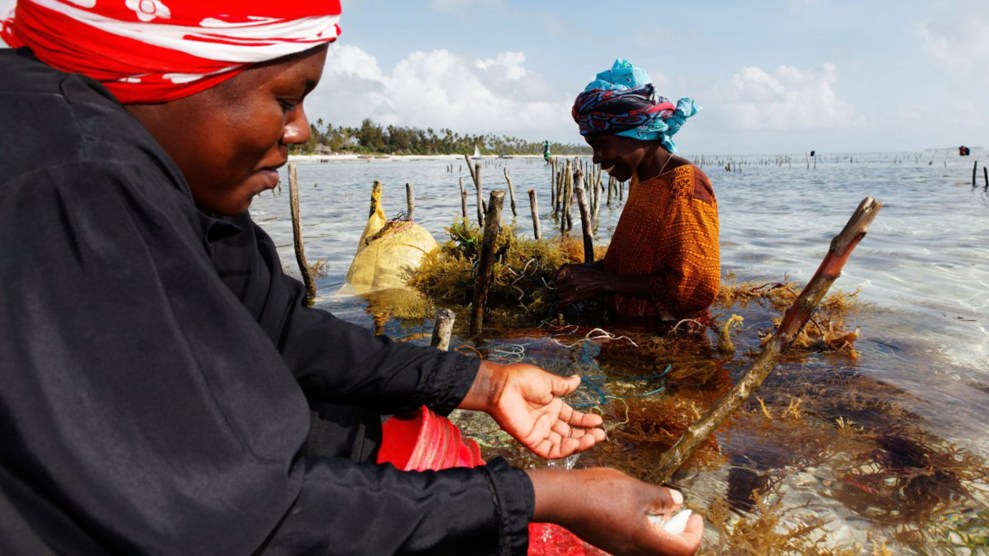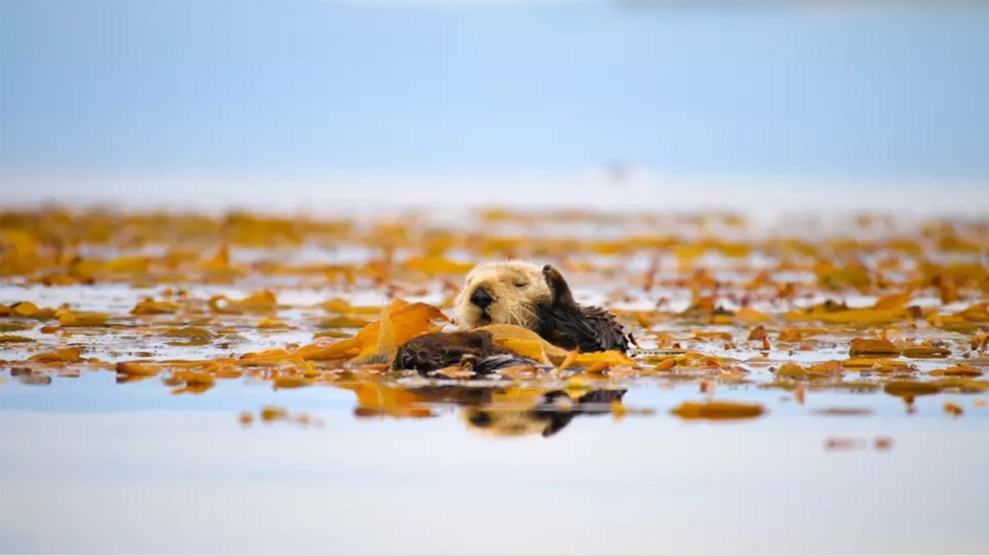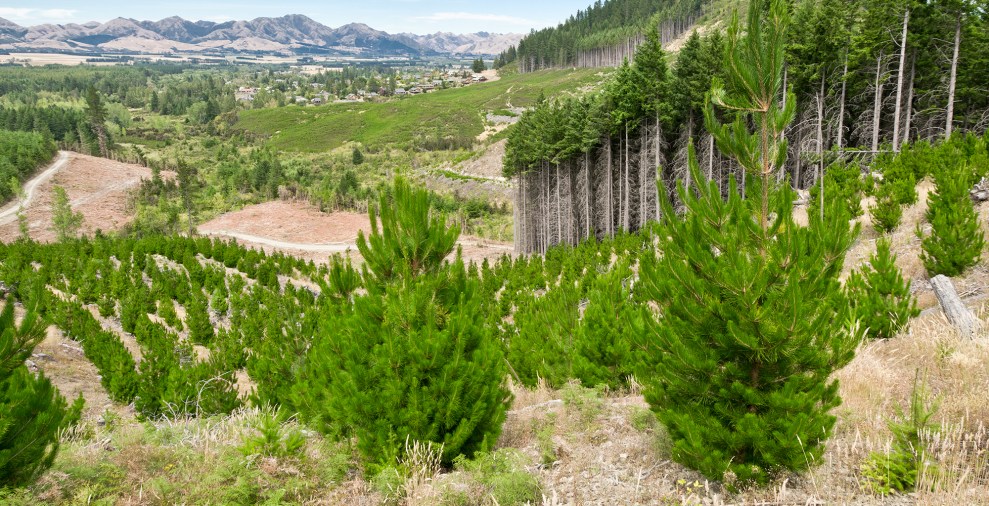
A commercial seaweed operation in Xiapu, China.Keren Su/China Span/Alamy
This story was originally published by Hakai Magazine and is reproduced here as part of the Climate Desk collaboration.
Cornelia Rindt steadies herself on a rocking boat while she and colleagues lean over the side to secure a meter-long tube of mud. It is her team’s first sample taken from the seafloor on British Columbia’s coastline. It will take more than a week to get just six more.
“It’s as much of an art as it is a science,” says Rindt, a project developer for BC-based consultancy Ostrom Climate Solutions (formerly NatureBank). The coring device has to be lowered blindly through 100 meters of water—too deep for divers to navigate—and land vertically at the right speed, rather than bouncing off a rock or tipping over in the currents, in order to capture a good slice of the soft sediment below. That will then go to the lab to determine how much carbon is locked inside. It takes maybe five tries to get a good sample, she says; some days they get nothing at all. Once, she remembers, the loose mud they pulled up flooded out of the tube before they could capture it: “That was 30 centimeters of sample that just went whoosh. It was deep green and I could smell the carbon.”
The sampling is part of Ostrom Climate Solutions’s effort to help fill in the giant scientific blanks about kelp, the group of large brown algae that make up the oceanic “forests” of Canada’s west coast. The company is making the effort at the behest of Coastal First Nations (CFN), an alliance of nine First Nations in British Columbia. The big question they seek to answer is just how much kelp sloughs off, like dead skin, and falls to the ocean floor for permanent storage in the sediment. In other words: just how good is kelp at locking up carbon and helping to fight climate change?
That work is needed to back the global push to make the aquatic resource eligible for carbon credits—a sometimes-controversial scheme whereby people can earn credit for stopping carbon dioxide from reaching the atmosphere, and sell that credit on to companies aiming to counteract their own emissions. Some players are anticipating seaweed, including kelps, could join the carbon-credit market as early as this year.
CFN is keen on the idea: if seaweed qualifies for carbon credits, then they could earn hard cash for restoring or farming kelp. Their communities “are very excited, because it’s a sustainable way of generating some income and giving back [to the ocean],” says Christine Smith-Martin, executive director of CFN who is from the Haida and Tsimshian First Nations.
Ostrom Climate Solutions isn’t alone in doing the science to back that idea. A global effort to understand the carbon potential of seaweed has also been spearheaded by Oceans 2050—an initiative cofounded in 2020 by Alexandra Cousteau (granddaughter of Jacques-Yves Cousteau and a well-regarded environmental activist in her own right) aiming to restore global ocean abundance. Like Ostrom Climate Solutions, they too are in the midst of their initial research into just how much carbon is stored under seaweed—and how much credit someone would deserve for helping seaweed to do that job.
Launched in October 2020, Oceans 2050’s 15-month seaweed research project has cored the seafloor under 21 seaweed farms in 13 countries on five continents. The majority of these are in Asia, but one is very close to where the Coastal First Nations live. Cascadia Seaweed, a three-year-old endeavor that has kelp farms in Barkley Sound, on the west coast of Vancouver Island, is Oceans 2050’s sole representative on the west coast of North America.
For Carlos Duarte, the chief science adviser behind Oceans 2050, seaweed farming looks like a vital contribution to saving the planet from climate change and restoring ocean life. In the future, Duarte envisions a world plastered with four million square kilometers of seaweed farms globally (2,000 times the current area of just 2,000 square kilometers), creating a thriving ecosystem for fish and collectively earning farmers billions of carbon credits a year. That’s a multibillion-dollar industry that hasn’t yet gotten started—but which could transform the oceans and a small slice of the carbon economy over the coming decades. Duarte calls it the “seaweed aquaculture imperative.”

Workers tend to seaweed in Matemwe, Tanzania. I
mage Professionals GmbH/Alamy
Carbon credits have been around since the 1990s. Projects that sequester carbon—like tree planting—can earn one sellable credit for every tonne of CO2 equivalent that is prevented from entering the atmosphere. Though a simple idea, the market has had a bumpy and controversial history. Some credits have, for example, perversely incentivized companies to raze one forest in order to plant another, or to avoid decarbonizing their own business.
Various nonprofit organizations oversee the voluntary market to verify and police carbon credits. The most widely used of these registry services is Washington, DC–based Verra, which runs the Verified Carbon Standard offset program. COP26, the United Nations climate meeting in Glasgow, Scotland, this past November gave a huge boost to the voluntary carbon-credit market by adopting new rules allowing nations to partially meet their emissions targets by buying these offsets. It’s a change that has helped to legitimize the market.
So far, Verra has certified more than 855 million carbon credits, almost entirely for land-based projects including avoided deforestation and reduced emissions from manufacturing—sectors that were better understood scientifically and had larger-scale projects already underway in the market’s early days. Only in recent years has Verra added marine-based or so-called blue carbon to their registry, from projects that conserve, restore, or expand mangroves, salt marshes, and seagrasses. Seaweed farming, observers say, is next in line. In August 2021, Verra launched a Seascape Carbon Initiative to help advance the blue-carbon market. “Seaweed farming has a lot of potential,” says Anne Thiel, communications manager for Verra.
While the scope for the blue-carbon market is smaller than for its land-based cousin, the price tag is typically higher. That’s because companies are willing to pay more for carbon credits that have side benefits for local populations and ecosystems, and that come with publicity-friendly stories and photos that buyers can paste into their advertisements and annual reports. While land-based-forestry carbon credits can go for less than US $1 per credit, blue-carbon credits have been known to fetch $15 or more.
Seaweed is a good candidate for these blue credits, advocates say. Fast-growing seaweed is an efficient carbon soaker-upper, gobbling up to 20 times more carbon than a terrestrial plant of the same volume. Admittedly, quite a lot of the uptake is only temporary: seaweeds don’t have roots to channel carbon underground; they often bloom and decline seasonally and can be wiped out by occasional storms or surges of predators like sea urchins; algae that are eaten by fish or decay release carbon back into the atmosphere; and bits that fall to the seafloor can be kicked up again by trawling. Yet, some seaweed carbon is also preserved in the seafloor for the long haul: some oil deposits have been shown to have come from degraded macroalgae, for example. This is the carbon that makes seaweed exciting as a climate change mitigator.
In 2016, Duarte and colleague Dorte Krause-Jensen pulled together the available evidence and estimated that seaweeds worldwide sequester a nontrivial amount of carbon. According to a report from the High Level Panel for a Sustainable Ocean Economy (Ocean Panel), it’s about 640 million metric tons of CO2 equivalents annually. But the margin of error is huge: it could be a third of that, or half as much again. The total is dwarfed by land-based forests, which, for comparison, soak up more than 10 times more than macroalgae (even when accounting for deforestation); but seaweed is still a significant carbon sink.
The same Ocean Panel report states that the global area covered by seaweed is holding relatively steady at about 3.5 million square kilometers of coast (an area larger than India). While some spots have been ravaged by climate change or pollution, other areas have grown, so the total coverage is thought to have dropped less than one percent over 50 years. This means that the biggest potential for boosting seaweed’s total carbon storage lies not in restoration projects (as is often done with mangroves, for example) but instead with farming. The Ocean Panel estimates that seaweed farming could absorb anything from 50 to 290 million metric tons of CO2 equivalents per year. Duarte’s published estimate is 239 million metric tons by 2050, equivalent to the annual emissions from about 52 million cars.
That’s still just a tiny sliver of less than one percent of global emissions, which are on the order of 50 billion metric tons of CO2 equivalents a year. But advocates in the fight against global warming say every bit helps. “Many people argue that if the number is not in the billion [metric ton] scale then don’t bother,” says Duarte, “but I tell them there are no low-hanging [billions].” We need to start with the millions, he says, and then ramp up to the billions.
Plus, Duarte and others note, seaweed has a host of side benefits: it can improve water quality, promote biodiversity, and reduce local ocean acidity for shellfish farms by soaking up CO2. Seaweed farming uses no fertilizers, pesticides, or fresh water, and can empower the women who often do this work in the developing world. While some critics worry about the rapid expansion of the industry spreading pests or changing ecosystems, Duarte says seaweed farming can be done sustainably and without significant impacts. “Seaweed farming is actually a good thing to do, within some bounds,” says Duarte. “The scope for growth is about 2,000-fold.”
So far, however, the profit margins on selling seaweed for sushi, seaweed snacks, and other products are too small to support the scale needed to help save the planet from global warming. To Duarte’s eye, adding carbon credits to the mix could make it a far more appealing enterprise for farmers.
It’s this winning combination of finance plus environmental protection that made the whole idea of carbon credits catch the attention of CFN in the first place. Around 2012, CFN made headlines by starting to sell carbon credits earned by avoiding deforestation and planting in the Great Bear Rainforest in their territory on the northern BC coast. Today, they earn up to a million credits each year, and successfully sell about half of them. At more than CAN $10 each, that currently earns them $4.5-million a year, with room to grow. After that project got up and running, CFN asked Ostrom Climate Solutions (then NatureBank) whether something similar might be done at sea: could they get cash credit for farming kelp?
With the data so spotty and the science base slim, no one yet knew. This is why Rindt was out on the water in the summer of 2021, getting samples from beneath natural kelp areas. “We’re kind of at this early stage of understanding,” says Rindt. Despite the challenges of trying to core the seafloor 100 meters down in often-bad weather during a pandemic, they managed to get seven good samples from five sites around the northern tip of Vancouver Island and the mainland coast farther north. Those samples have been sent to a lab to analyze how much carbon is there and, from the isotopic signatures, how much came from kelp. They await their results, and plan to later sample more spots along the BC coast.
For the Oceans 2050 project, seaweed biologist Jennifer Clark helped to collect a few samples from under Cascadia Seaweed’s farms in 2021. For their shallower waters, divers could do the job. Meanwhile, the other farms worldwide were doing the same, sending all their samples to a lab in Monaco for analysis. As of the end of 2021, Oceans 2050 had full data for five farms. The results, Duarte says, roughly match his calculated estimate of three metric tons of CO2 being stored in sediments per hectare—but with a huge range, depending on everything from the type of seaweed to the local ocean currents and whether the seafloor is rocky or not.
Those initial results are encouraging, says Duarte, especially in the tropics. They anticipate their full results will be presented in March 2022.
When all the data is in, it needs to be converted into a solid methodology for carbon credits—a rule book determining how many credits someone can earn, and the steps they’ll need to take to prove it. Individual farmers could use default values for carbon credits based on models that are fed with data such as seaweed type and water depth, or they could do some of their own coring to prove their particular potential for carbon storage. Duarte guesses a seaweed farmer could be looking at earning on the order of tens of carbon credits per hectare of farm per year. “All we have now is hand-waving,” he says. Verra confirms that Oceans 2050 has submitted a “concept note” for a new methodology for seaweed farming, the first formal step in the carbon-credit approval process. CFN and Ostrom Climate Solutions haven’t yet chosen the verification scheme they’ll go with.
Until approved, kelp carbon credits aren’t a reliable cash cow. “In my view, it’s too early for seaweed harvesters to be trying to jump on the carbon bandwagon,” says Bill Collins, marine geologist and founding partner of Cascadia Seaweed. “It needs to be led by science.” For now, Cascadia has 20 hectares of farm, with plans to ramp up to perhaps 1,000 hectares in the future. Extrapolating from Duarte’s rough figures, that means they could eventually earn on the order of 10,000 credits a year, with a value of about $100,000 at prices around $10 per credit. Overall, Collins suspects there’s more profit to be made in kelp products than in carbon credits. But if kelp gets formally recognized—by being added to Verra’s books, for example—“we may get more excited,” he says.
Collins adds there may be even more environmental ways of looking at seaweed rather than focusing on carbon storage in sediment. “My instinct is that there will be better support for the planet by growing it and feeding it to cows,” he says. Livestock are responsible for a surprisingly large chunk of greenhouse gas emissions (14.5 percent of the global total), thanks mainly to methane burps from ruminants. Previous work has shown that sprinkling red seaweed in feed can reduce those emissions by as much as 82 percent. That’s a whole other way that seaweeds might qualify for carbon credits—but, in this case, it would be the cattle farmers, not the seaweed producers, claiming those credits and getting that cash. Similarly, kelp can be turned into all manner of products—textiles, concrete, and more—that would store the carbon away for the long term.
“It’s pretty exciting,” says Smith-Martin about the possibilities of incorporating carbon credits into the CFN’s efforts to holistically protect the land and sea. “I’m pretty sure our ancestors would have seen the value.” Each First Nation in their alliance, she notes, has their own plans for how they might incorporate kelp carbon credits into their coastal management, but all are excited about the opportunities for jobs, for expanding productive coastal ecosystems, and for a possible novel cash stream. “You don’t get very many opportunities to build on the abundance that we do have, or we did have at one time in our oceans,” she says. “It’s an exciting time.”
For now, though, the real excitement is happening in the labs, as Rindt and Duarte comb through the data they need to introduce seaweed into the carbon-credit market. To get to that envisioned future of productive, lucrative kelp farms, first they have to sort through some tubes of mud.












